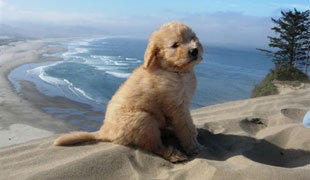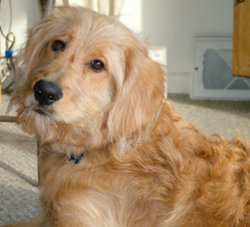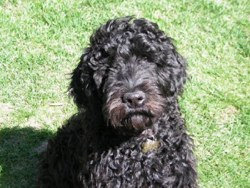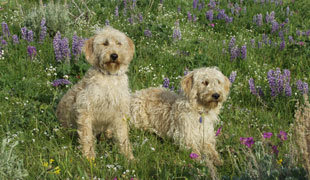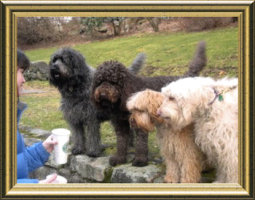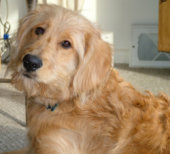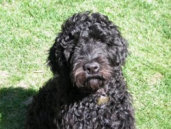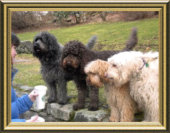
© Copyright Goldendoodles.com 2001. All rights reserved. You may not copy or otherwise use anything on this site without our written permission.
DOODS & GENERATIONS
First Generation Goldendoodles - F1
A first generation hybrid Goldendoodle is the product of a Golden Retriever and a Poodle. As first generation hybrids, these dogs have the added health benefits associated to Hybrid Vigour. This is a phenomenon in animal breeding referring to the fact that the first cross between two unrelated purebred lines is healthier and grows better than either parent line. (photo courtesy of Big Oak Farm) Coat Maintenance: moderate to high care Coat Description: Coat grows to a natural body length of 3-5 inches which requires combing and occasional grooming. Many choose to have the fur cut back once every few months to keep the fur shorter and easier to maintain. Coats are usually wavy or curly, with a rare shorter hair coat. Shedding: mostly very light to nonshed (see the stats in the Dood Database) Allergy Friendliness: usually successful in families with mild allergies. When a family has moderate to severe allergies, a backcross Dood is recommended.First Generation Backcross Goldendoodles
- F1b
A backcross pup is the result of a hybrid bred back to one of its breeds of origin. From a genetic standpoint a backcross pup is a first generation cross. As breeders are breeding towards nonshedding and allergy friendliness, a backcross Goldendoodle is generally the product of a Goldendoodle bred to a Poodle. The resulting dog is, on average, 1/4 Golden Retriever and 3/4 Poodle. Although there is less vigour in this crossing than in the original hybrid, the first generation backcross still is close enough in the breeding tree to benefit from hybrid vigour. With each successive generation vigour is lost. Coat Maintenance: moderate to high care Coat Description: Coat continues to grow in length although similar in appearance to a first generation Goldendoodle. Coats are wavy or curly. Shedding: very light to nonshed (see the stats in the Dood Database) Allergy Friendliness: recommended for families with moderate to severe allergies.Second Generation Goldendoodles - F2
A second generation Goldendoodle (F2) is the result of a Goldendoodle bred to a Goldendoodle - and there are very few of these actually bred as the second generation hybrid is genetically the most varied generation possible. (see study below on wolf-poodle hybrids) When breeding on, most Goldendoodle breeders breed a backcross instead, as the pups are more predictable, and work well for people with allergies Coat Maintenance: varies on the coat type Coat Description: The coat can be a hair coat, wavy coat, or curly coat. Shedding: varies greatly from shedders to nonshedders Allergy Friendliness: not recommended for families with allergies, due to the varying coat types. First generation hybrids are all exactly 50% of each parent breed. Half their chromosomes from one parent, half from the other. Dogs have 78 chromosomes, so picture 39 white marbles and 39 black marbles, each colour representing a parent breed, in a large bowl representing the chromosomes of each dog. When these hybrids reproduce, each sperm or egg will contain '39 marbles randomly picked from the large bowl'. Statistically the random mix will be somewhat evenly distributed, but it is theoretically possible though unlikely to 'pull out 39 black marbles' and also produce a purebred of either parent breed. Dr. Kate Schoeffel, honours geneticist, Vet and Dood breeder, has a great page on the genetics here - https://katesfamilypets.com/inbreeding-linebreeding-and- crossbreeding-in-dogs/ There was an intersting study done in 1976 by C. Schleifenbaum looking into the fur marks and coat color in wolves and poodle-wolf hybrids, raised in Kiel. (Zeitschrift fuer Saeugetierkunde, 41(3):147-167. BA 62:60461 ZR 113(19):148). It shows how greatly varied the coat types are in a second generation hybrid. The first generation poodle-wolf hybrid - uniform coats. The second generation poodle-wolf hybrid - varied coats.Second Generation Backcross Goldendoodles -
F2b
A second generation backcross pup (F2B) is the result of a Goldendoodle (F1) bred to a Goldendoodle backcross (F1b). Although three generations in the making, F2Bs are technically second generation dogs. 1st generation pup - Golden Retriever x Poodle - F1 1st generation pup - Goldendoodle x Poodle - F1b 2nd generation pup - Goldendoodle backcross x Goldendoodle - F2B Although there is less vigour in this generation than in the first, the second generation backcross still is close enough in the breeding tree to the original hybrid to benefit from hybrid vigour. With each successive generation vigour is lost. Coat Maintenance: moderate to high care Coat Description: Coat continues to grow in length although similar in appearance to a first generation Goldendoodle. Coats are wavy or curly. Shedding: mostly nonshed Allergy Friendliness: recommended for families with moderate to severe allergies.First Generation Labradoodles - F1
A first generation hybrid Labradoodle is the product of a Labrador Retriever and a Poodle. The term 'Labradoodle' was coined by Wally Conron of the Australian Guide Dog Association, when he first bred these hybrids as allergy friendly service dogs. The AGDA still uses first generation Labradoodles upon demand to this day. As first generation hybrids, these dogs have the added health benefits associated to Hybrid Vigour. This is a phenomenon in animal breeding referring to the fact that the first cross between two unrelated purebred lines is healthier and grows better than either parent line. Coat Maintenance: Low care Coat Description: Coat grows to about 2-3 inches in length and requires occasional combing. Coats are often hair coats, and others can have wavy or curly coats. Shedding: light to nonshed (see the stats in the Dood Database) Allergy Friendliness: usually successful in families with mild allergies. When a family has moderate to severe allergies, a backcross Dood is recommended.First Generation Backcross Labradoodles -
F1b
A backcross pup is the result of a hybrid bred back to one of its breeds of origin. From a genetic standpoint a backcross pup is a first generation cross. As breeders are breeding towards nonshedding and allergy friendliness, a backcross Labradoodle is generally the product of a Labradoodle bred to a Poodle. The resulting dog is, on average, 1/4 Labrador Retriever and 3/4 Poodle. Although there is less vigour in this crossing than in the original hybrid, the first generation backcross still is close enough in the breeding tree to benefit from hybrid vigour. With each successive generation vigour is lost. Coat Maintenance: moderate to high care Coat Description: Coat continues to grow in length and requires combing and occasional grooming. It is usually thicker and curlier than a first generation Labradoodle with a wavy or curly coat. Shedding: very light to nonshed (see the stats in the Dood Database) Allergy Friendliness: Backcross Labradoodles are recommended for families with moderate to severe allergies.Multi-generation Labradoodles
Technically a multigeneration Labradoodle should be the result of generations of Labradoodle to Labradoodle breeding, but in practice backcrosses and poodles are also used in the early generations. When multigeneration Labradoodles were first introduced to North American breeders, they were given a Lab-Poodle breeding program as the breeding model for Labradoodles, which suggesteded that Poodles could be reintroduced into the early generations. This breeding program allowed breeding to poodles for the first four generations - which is why in some older lines of multigen dogs, 'there is a lot of poodle in the doodle'. Poodles are less expensive, they make shedding lines more nonshed, and they allow the introduction of some popular new colours such as red and parti. Good breeders are selective about adding only a modest amount of poodle in the early generations. Coat Maintenance: moderate to high care Coat Description: Coat continues to grow in length and requires combing and occasional grooming. It is thicker than a first generation Labradoodle and can have a curly, fleece or wavy coat type. Shedding: almost all nonshed (see the stats in the Dood Database) Allergy Friendliness: Multigeneration Labradoodles are recommended for families with moderate to severe allergies.Australian Labradoodles
In 2004, the name Australian Labradoodle was used to describe the lines of multigeneration Labradoodles with long pedigrees, some dating back to the two kennels in Australia who started breeding them in the early 1990's. It was later announced was that there were in fact six breeds used in the breeding program; Poodle, Labrador Retriever, Irish Water Spaniel, Curly Coat Retriever, American Cocker Spaniel, English Cocker Spaniel. The Curly Coated Retriever experiment was a failure and those lines were abandoned. Only two Irish Water Spaniels were used, and only one time each. This left the main contributors as : Labrador, Poodle and American & English Cocker Spaniels. Multigeneration Labradoodles from Australia started to take off in North America in the late 1990's. Now there are a large number of breeders in North America and in Australia who own breeding dogs from these lines. They are working together to push for higher standards in health testing, to broaden the genetic foundation and to better the breed as a whole. The Labradoodle Association of Australia (LAA) is the founding parent body of the Australian Labradoodle. It is their vision to work with the Australian National Kennel Club (ANKC) towards breed recognition in Australia - a process which takes decades of breeding towards conformity. The Australian Labradoodle Association of America (ALAA) protects the welfare of the Labradoodle and Australian Labradoodle breeds. Coat Maintenance: moderate to high care Coat Description: They have wool, 'new wool', fleece or hair coats which continue to grow in length and require combing and occasional grooming. Wool coats are curly and poodly in texture. The 'new wool' has a more relaxed and softer curl. A fleece coat has a relaxed curl and is softer than wool coats. Hair coats are rare and are flat, shedding and not allergy friendly. Shedding: almost all nonshed Allergy Friendliness: Australian Labradoodles are recommended for families with moderate to severe allergies. For more information see our page on the Australian Labradoodle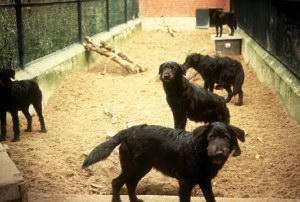




(top photo courtesy of Timshell Farm)
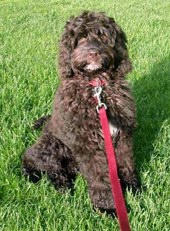
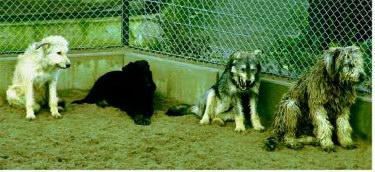

Goldendoodles.com

© Copyright Goldendoodles.com 2001. All rights reserved. You may not
copy or otherwise use anything on this site without our written permission
DOODS &
GENERATIONS
First Generation
Goldendoodles - F1
A first generation hybrid Goldendoodle is the product of a Golden Retriever and a Poodle. As first generation hybrids, these dogs have the added health benefits associated to Hybrid Vigour. This is a phenomenon in animal breeding referring to the fact that the first cross between two unrelated purebred lines is healthier and grows better than either parent line. (photo courtesy of Big Oak Farm) Coat Maintenance: moderate to high care Coat Description: Coat grows to a natural body length of 3-5 inches which requires combing and occasional grooming. Many choose to have the fur cut back once every few months to keep the fur shorter and easier to maintain. Coats are usually wavy or curly, with a rare shorter hair coat. Shedding: mostly very light to nonshed (see the stats in the Dood Database) Allergy Friendliness: usually successful in families with mild allergies. When a family has moderate to severe allergies, a backcross Dood is recommended.First Generation
Backcross
Goldendoodles - F1b
A backcross pup is the result of a hybrid bred back to one of its breeds of origin. From a genetic standpoint a backcross pup is a first generation cross. As breeders are breeding towards nonshedding and allergy friendliness, a backcross Goldendoodle is generally the product of a Goldendoodle bred to a Poodle. The resulting dog is, on average, 1/4 Golden Retriever and 3/4 Poodle. Although there is less vigour in this crossing than in the original hybrid, the first generation backcross still is close enough in the breeding tree to benefit from hybrid vigour. With each successive generation vigour is lost. Coat Maintenance: moderate to high care Coat Description: Coat continues to grow in length although similar in appearance to a first generation Goldendoodle. Coats are wavy or curly. Shedding: very light to nonshed (see the stats in the Dood Database) Allergy Friendliness: recommended for families with moderate to severe allergies.Second Generation
Goldendoodles - F2
A second generation Goldendoodle (F2) is the result of a Goldendoodle bred to a Goldendoodle - and there are very few of these actually bred as the second generation hybrid is genetically the most varied generation possible. (see study below on wolf-poodle hybrids) When breeding on, most Goldendoodle breeders breed a backcross instead, as the pups are more predictable, and work well for people with allergies Coat Maintenance: varies on the coat type Coat Description: The coat can be a hair coat, wavy coat, or curly coat. Shedding: varies greatly from shedders to nonshedders Allergy Friendliness: not recommended for families with allergies, due to the varying coat types. First generation hybrids are all exactly 50% of each parent breed. Half their chromosomes from one parent, half from the other. Dogs have 78 chromosomes, so picture 39 white marbles and 39 black marbles, each colour representing a parent breed, in a large bowl representing the chromosomes of each dog. When these hybrids reproduce, each sperm or egg will contain '39 marbles randomly picked from the large bowl'. Statistically the random mix will be somewhat evenly distributed, but it is theoretically possible though unlikely to 'pull out 39 black marbles' and also produce a purebred of either parent breed. Dr. Kate Schoeffel, honours geneticist, Vet and Dood breeder, has a great page on the genetics here - https://katesfamilypets.com/inbreeding- linebreeding-and-crossbreeding-in- dogs/ There was an intersting study done in 1976 by C. Schleifenbaum looking into the fur marks and coat color in wolves and poodle-wolf hybrids, raised in Kiel. (Zeitschrift fuer Saeugetierkunde, 41(3):147-167. BA 62:60461 ZR 113(19):148). It shows how greatly varied the coat types are in a second generation hybrid. The first generation poodle-wolf hybrid - uniform coats. The second generation poodle-wolf hybrid - varied coats.Second Generation
Backcross
Goldendoodles - F2b
A second generation backcross pup (F2B) is the result of a Goldendoodle (F1) bred to a Goldendoodle backcross (F1b). Although three generations in the making, F2Bs are technically second generation dogs. 1st generation pup - Golden Retriever x Poodle - F1 1st generation pup - Goldendoodle x Poodle - F1b 2nd generation pup - Goldendoodle backcross x Goldendoodle - F2B Although there is less vigour in this generation than in the first, the second generation backcross still is close enough in the breeding tree to the original hybrid to benefit from hybrid vigour. With each successive generation vigour is lost. Coat Maintenance: moderate to high care Coat Description: Coat continues to grow in length although similar in appearance to a first generation Goldendoodle. Coats are wavy or curly. Shedding: mostly nonshed Allergy Friendliness: recommended for families with moderate to severe allergies.First Generation
Labradoodles - F1
A first generation hybrid Labradoodle is the product of a Labrador Retriever and a Poodle. The term 'Labradoodle' was coined by Wally Conron of the Australian Guide Dog Association, when he first bred these hybrids as allergy friendly service dogs. The AGDA still uses first generation Labradoodles upon demand to this day. As first generation hybrids, these dogs have the added health benefits associated to Hybrid Vigour. This is a phenomenon in animal breeding referring to the fact that the first cross between two unrelated purebred lines is healthier and grows better than either parent line. Coat Maintenance: Low care Coat Description: Coat grows to about 2-3 inches in length and requires occasional combing. Coats are often hair coats, and others can have wavy or curly coats. Shedding: light to nonshed (see the stats in the Dood Database) Allergy Friendliness: usually successful in families with mild allergies. When a family has moderate to severe allergies, a backcross Dood is recommended.First Generation
Backcross
Labradoodles - F1b
A backcross pup is the result of a hybrid bred back to one of its breeds of origin. From a genetic standpoint a backcross pup is a first generation cross. As breeders are breeding towards nonshedding and allergy friendliness, a backcross Labradoodle is generally the product of a Labradoodle bred to a Poodle. The resulting dog is, on average, 1/4 Labrador Retriever and 3/4 Poodle. Although there is less vigour in this crossing than in the original hybrid, the first generation backcross still is close enough in the breeding tree to benefit from hybrid vigour. With each successive generation vigour is lost. Coat Maintenance: moderate to high care Coat Description: Coat continues to grow in length and requires combing and occasional grooming. It is usually thicker and curlier than a first generation Labradoodle with a wavy or curly coat. Shedding: very light to nonshed (see the stats in the Dood Database) Allergy Friendliness: Backcross Labradoodles are recommended for families with moderate to severe allergies.Multi-generation
Labradoodles
Technically a multigeneration Labradoodle should be the result of generations of Labradoodle to Labradoodle breeding, but in practice backcrosses and poodles are also used in the early generations. When multigeneration Labradoodles were first introduced to North American breeders, they were given a Lab-Poodle breeding program as the breeding model for Labradoodles, which suggesteded that Poodles could be reintroduced into the early generations. This breeding program allowed breeding to poodles for the first four generations - which is why in some older lines of multigen dogs, 'there is a lot of poodle in the doodle'. Poodles are less expensive, they make shedding lines more nonshed, and they allow the introduction of some popular new colours such as red and parti. Good breeders are selective about adding only a modest amount of poodle in the early generations. Coat Maintenance: moderate to high care Coat Description: Coat continues to grow in length and requires combing and occasional grooming. It is thicker than a first generation Labradoodle and can have a curly, fleece or wavy coat type. Shedding: almost all nonshed (see the stats in the Dood Database) Allergy Friendliness: Multigeneration Labradoodles are recommended for families with moderate to severe allergies.Australian
Labradoodles
In 2004, the name Australian Labradoodle was used to describe the lines of multigeneration Labradoodles with long pedigrees, some dating back to the two kennels in Australia who started breeding them in the early 1990's. It was later announced was that there were in fact six breeds used in the breeding program; Poodle, Labrador Retriever, Irish Water Spaniel, Curly Coat Retriever, American Cocker Spaniel, English Cocker Spaniel. The Curly Coated Retriever experiment was a failure and those lines were abandoned. Only two Irish Water Spaniels were used, and only one time each. This left the main contributors as : Labrador, Poodle and American & English Cocker Spaniels. Multigeneration Labradoodles from Australia started to take off in North America in the late 1990's. Now there are a large number of breeders in North America and in Australia who own breeding dogs from these lines. They are working together to push for higher standards in health testing, to broaden the genetic foundation and to better the breed as a whole. The Labradoodle Association of Australia (LAA) is the founding parent body of the Australian Labradoodle. It is their vision to work with the Australian National Kennel Club (ANKC) towards breed recognition in Australia - a process which takes decades of breeding towards conformity. The Australian Labradoodle Association of America (ALAA) protects the welfare of the Labradoodle and Australian Labradoodle breeds. Coat Maintenance: moderate to high care Coat Description: They have wool, 'new wool', fleece or hair coats which continue to grow in length and require combing and occasional grooming. Wool coats are curly and poodly in texture. The 'new wool' has a more relaxed and softer curl. A fleece coat has a relaxed curl and is softer than wool coats. Hair coats are rare and are flat, shedding and not allergy friendly. Shedding: almost all nonshed Allergy Friendliness: Australian Labradoodles are recommended for families with moderate to severe allergies. For more information see our page on the Australian Labradoodle








